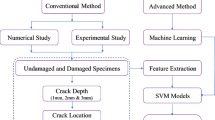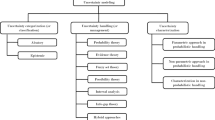Abstract
This study proposed a damage identification method compared with the existing ones, based on relative curvature difference and frequency perturbation theory, showing sensitivity to local damage by changes in the curvature mode and high recognition accuracy of frequencies. Considering the relative curvature difference as a damage index, numerical simulation is used for a simply supported beam under single and multiple damage conditions for different damage degrees. The damage is located according to the curvature mode curves, and the damage degree is qualitatively determined. Based on the perturbation theory, the damage equations are established by the changes between frequencies before and after damage, and the damage localization and degree are verified and determined. Effectiveness of the proposed method for identifying damage at different conditions is numerically investigated. This method potentially promotes the development of damage identification of beam structures.
































Similar content being viewed by others
References
Pandey AK, Biswas M, Samman MM. Damage detection from changes in curvature mode shapes. J Sound Vib. 1991;145(2):321–32.
Pandey AK, Biswas M. Damage detection in structures using changes in flexibility. J Sound Vib. 1994;169(1):3–17.
Zheng Minggang, Liu Tianxiong, et al. Bridge diagnosis using curvature mode shape. Vib Shock. 2000;19(2):81–2.
Chandrashekhar M, Ganguli R. Structural damage detection using modal curvature and fuzzy logic. Struct Health Monit. 2009;8(4):267–82.
Wang ZX, Qiao P, Xu J. Vibration analysis of laminated composite plates with damage using the perturbation method. Compos B Eng. 2015;72:160–74.
An YH, Blachowski B, Ou JP. A degree of dispersion-based damage localization method. Struct Control Health Monit. 2016;23(1):176–92.
Ciambella J, Pau A, Vestroni F. Effective filtering of modal curvatures for damage identification in beams. Procedia Eng. 2017;199:1876–81.
Yang ZB, Radzienski M, Kudela P, et al. Two-dimensional modal curvature estimation via Fourier spectral method for damage detection. Compos Struct. 2016;148:155–67.
He WY, He J, Ren WX. Damage localization of beam structures using mode shape extracted from moving vehicle response. Measurement. 2018;121:276–85.
Shi JY, Spencer BF, Chen SS. Damage detection in shear buildings using different estimated curvature. Struct Control Health Monit. 2018;25(1):e2050.
Cao SC, Ouyang HJ, Cheng L. Baseline-free adaptive damage localization of plate-type structures by using robust PCA and Gaussian smoothing. Mech Syst Signal Proc. 2019;122:232–46.
Ciambella J, Pau A, Vestroni F. Modal curvature-based damage localization in weakly damaged continuous beams. Mech Syst Signal Process. 2019;121:171–82.
Patil DP, Maiti SK. Detection of multiple cracks using frequency measurements. Eng Fract Mech. 2003;70(12):1553–72.
Xie J, Han DJ. An improved structural damage identification method based on frequency measurement. Eng Mech. 2004;21(1):21–5.
Du SY, Yin XG, Chen H. Perturbation finite element method for identifying structural damage based on frequency variation. Eng Mech. 2007;24(4):66–70.
Chen H, He W, et al. Structural damage identification based on frequency and vibration mode perturbation. Eng Mech. 2010;27(12):244–9.
Du SY, Yin XG, Chen H, et al. Identification of structural health test BENCHMARK problem based on frequency perturbation theory. J Appl Mech. 2010;27(4):674–9.
Mekjavić I. Bridge damage identification from measured natural frequencies. In: Proceedings of the RILEM International workshop on performance-based specification and control of concrete durability/Bjegović, D. Beushausen, H. Serdar, M, 2014
Mekjavić I, Damjanović D. Damage assessment in bridges based on measured natural frequencies. Int J Struct Stab Dyn. 2016;17(02):5.
Capecchi D, Ciambella J, Pau A, et al. Damage identification in a parabolic arch by means of natural frequencies, modal shapes and curvatures [J]. Meccanica. 2016;51(11):2847–59.
Mao L, Lu Y. Experimental study of sensitivity-aided application of artificial boundary condition frequencies for damage identification. Eng Struct. 2017;134:253–61.
Zhao Y, Ren YC. Damage identification of beam with breathing crack under fractal dimension[J]. IOP Conf. Series: Mat Sci Eng. 2018;322(042027):1–7.
Dahak M, Touat N, Kharoubi M. Damage detection in beam through change in measured frequency and undamaged curvature mode shape. Inverse Prob Sci Eng. 2018;2:1–26.
Li DB, Lu QH. Experimental modal analysis and its application. Beijing: Science Press; 2001.
Du SY, Yin XG, Chen H. Structural damage identification method based on frequency 2nd order perturbation. J Appl Mech. 2006;23(4):613–7.
Acknowledgements
This study is supported by the National Natural Science Foundation of China under Grant No. 51278420, and the Natural Science Foundation of Shaanxi Province under Grant No. 2017JM5021.
Author information
Authors and Affiliations
Corresponding author
Rights and permissions
About this article
Cite this article
Li, M., Wu, Z., Yang, H. et al. Localization and Degree of Damage Based on Relative Curvature Difference and Frequency Perturbation. Acta Mech. Solida Sin. 33, 187–204 (2020). https://doi.org/10.1007/s10338-019-00138-y
Received:
Revised:
Accepted:
Published:
Issue Date:
DOI: https://doi.org/10.1007/s10338-019-00138-y




